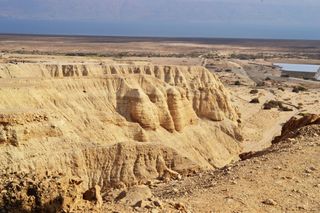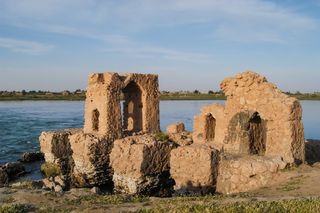7 Biblical Sites Ravaged by Modern-Day Looters
Biblical ruins

Biblical sites draw interest from many people: archaeologists, historians, priests, rabbis, imams and many members of the general public. Sadly, these historical ruins from the time of Jesus also often attract looters, people who illegally excavate a site, often in hopes of selling what they find. War, poverty and demand from artifact collectors, who are sometimes willing to pay large sums for biblical artifacts, help drive the looting. Here, Live Science takes a look at seven biblically important archaeological sites that have been plundered by modern-day looters.
Caves near Qumran

Inside 12 caves at Qumran, archaeologists discovered the now-famous Dead Sea Scrolls, which consist of fragments from 900 manuscripts that include some of the earliest copies of the Hebrew Bible. Shortly after the first few scrolls were discovered, in 1947, looters began cleaning out those caves. In fact, looters, not archaeologists, found many of the scrolls. A lot of these scrolls were sold through an antiquities dealer named Khalil Iskander Shahin (also known as "Kando") in Bethlehem.
In 2017, a Dead Sea Scroll was found in another Qumran cave, though there was no writing on it. The cave had been looted, with archaeologists finding the remains of what appear to be modern-day pickaxes. Looters have also plundered other caves found since that time, and archaeologists have launched a campaign to find and excavate any caves near Qumran that contain archaeological remains.
Nineveh

Nineveh, an ancient Assyrian city located in what is now Iraq, appears numerous times in the Bible. For instance, the Book of Nahum records a prophecy, supposedly given by a man named Nahum, which predicted the destruction of Nineveh. This came to be in 612 B.C., when army made up of troops from Medes (a kingdom in modern-day Iran) and Babylon attacked the city.
Sadly, the past decade has not been kind to Nineveh. In June 2014, the terrorist group ISIS (also known as ISIL or Daesh) captured Nineveh and occupied it until January 2017. During that time, the terrorist group destroyed the tomb of Jonah, a holy site for both Muslims and Christians. Looters dug a system of tunnels beneath the remains of the destroyed tomb. It's unclear exactly how many artifacts thieves looted from beneath the tomb. After Nineveh was retaken by Iraqi troops, the remains of inscriptions were found within the tunnels.
Dura-Europos

Dura-Europos, an ancient city in southeastern Syria, is home to the earliest known Christian church, dating to A.D. 230. The church has a courtyard, meeting hall and baptistery (a place used for baptisms). The baptistery displays a number of wall paintings of Christian scenes, including one depicting Jesus walking on water.
The Syrian civil war has hit this site hard. Analysis of satellite photos taken between 2011 and 2014 reveals that the site was "subjected to extremely heavy looting," a report published by the American Association for the Advancement of Science found. The terrorist group ISIS captured Dura-Europos in 2014. The Syrian army recaptured the area in December 2017. At present, it's not certain how much of the city and its early Christian church remains.
One consolation is that over 12,000 artifacts from Dura-Europos are at the Yale University Art Gallery in the United States. These items were excavated in the 1920s and 1930s by an archaeological team from Yale and the French Academy of Inscriptions and Letters.
Bethlehem

Located in the West Bank, Bethlehem is famous as the biblical birthplace of Jesus; archaeological remains show that Bethlehem and nearby areas have been inhabited for thousands of years. One recently discovered necropolis holds tombs that date back more than 4,000 years, although looting or construction had destroyed part of the necropolis.
Quite a bit of looting has damaged the area's ancient tombs and archaeological sites. The looting is aggravated by unemployment, poverty and the limited resources of Palestine's antiquities service. Palestinian archaeologists have noted that the ongoing Israeli-Palestinian conflict worsens the situation, bringing poor security, higher poverty rates, and the damage or destruction of archaeological sites.
One study, published in the Journal of Mediterranean Archaeology, found that some looters in the Bethlehem area, in their desperation to find artifacts to sell, have even turned to spirit possession in hopes of finding golden artifacts.
Al-Yahudu

When the Babylonian King Nebuchadnezzar II forced a community of Jews out of Judah, they relocated in Al-Yahudu (a name that can be translated to "village of the Jews" or "town of the Jews"). That site is located someplace in what is now Iraq.
The settlement is known from the Hebrew Bible, which describes how, after Jerusalem was captured by the Babylonians in 587 B.C., the first temple was destroyed and much of the Jewish population was forcibly relocated to Mesopotamia. (Most of Iraq is within the boundaries of the historical region called Mesopotamia.)
Tablets from Al-Yahudu have been appearing on the antiquities market over the past 20 years. The tablets describe the lives of some of the people who were forcibly exiled, showing how they retained their Jewish religion and customs while adapting to life within the Babylonian Empire. Despite the importance of Al-Yahudu, archaeologists do not know where the site is within Iraq, although looters do. At present, more than 200 tablets from Al-Yahudu are known to exist. When archaeologists do find the location of this ancient settlement, they will likely find that it has been heavily looted.
Nimrud

The Book of Genesis tells how the ancient Assyrian city of Nimrud (known in the Hebrew Bible as "Calah") was built by a "mighty warrior" and "mighty hunter" named Nimrod. Genesis also claims that Nimrod was the great-grandson of Noah. Famously, of course, Noah followed God's command and built an ark to house his own family as well as male and female pairs of every animal on Earth, protecting them from a great flood that God created.
Modern-day looting and destruction have devastated Nimrud. The city was looted during the 2003 U.S. invasion of Iraq, and artifacts from the city that were in the National Museum of Iraq, in Baghdad, were also taken. In June 2014, ISIS captured Nimrud, destroyed much of the ancient city and may also have looted some of it. The city was retaken in November 2016 by Iraqi troops; for more than a month, there was little security at the site, however, and media reports indicate that more looting took place.
Tyre

The ancient city of Tyre, located in what is now Lebanon, is mentioned numerous times in the Bible. For instance, a king of Tyre name Hiram sent cedar wood and skilled workers to King David and King Solomon, the Hebrew Bible says. These resources and laborers helped build the first temple, the holiest site in Judaism. The Hebrew Bible also describes how Solomon and Hiram collaborated to create fleets of ships that conducted trade in the eastern Mediterranean and trade with an unknown land called "Ophir" that was rich in gold.
Tyre has fallen victim to looting over the last 50 years. Wars and poor economic conditions have hit Lebanon periodically over that time, creating conditions that have permitted large-scale looting.
For example, in 1989, a stone sarcophagus at Tyre "was blown up so that broken sculpture chunks could be carried to the marketplace," wrote Helga Seeden, an archaeology professor at the American University of Beirut, in a paper published in the book "The Presented Past: Heritage, Museums and Education" (Routledge, 1994).
Then, in 1990, looters discovered and pillaged a cemetery, possibly used for the burial of children. "According to local information, some 200 stone stelae together with several dozens of cinerary urns and other typical Iron Age pottery vessels were unearthed," wrote Hélène Sader, an archaeology professor at the American University of Beirut, in an article published in the journal Berytus Archaeological Studies in 1991.
Sign up for the Live Science daily newsletter now
Get the world’s most fascinating discoveries delivered straight to your inbox.

Owen Jarus is a regular contributor to Live Science who writes about archaeology and humans' past. He has also written for The Independent (UK), The Canadian Press (CP) and The Associated Press (AP), among others. Owen has a bachelor of arts degree from the University of Toronto and a journalism degree from Ryerson University.
